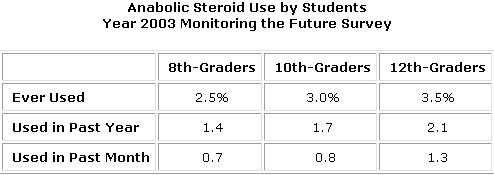NIDA Info Facts Steroids
Download PDF Version What is PDF?
Source: NIDA InfoFacts Steroids (Anabolic-Androgenic), National Institute on Drug Abuse. March
,2004. http://www.drugabuse.gov/infofax/heroin.html, February 1
2005.
Public Domain
Table of Contents (TOC)
Chapter 1: Steroids (Anabolic-Androgenic)Chapter 2: Health Hazards
Chapter 3: Extent of Use
References
 Anabolic-androgenic steroids are man-made substances related to male
sex hormones. “Anabolic” refers to muscle-building, and “androgenic” refers
to increased masculine characteristics. “Steroids” refers
to the class of drugs. These drugs are available legally only by prescription,
to treat conditions that occur when the body produces abnormally low
amounts of testosterone, such as delayed puberty and some types of impotence.
They are also prescribed to treat body wasting in patients with AIDS
and other diseases that result in loss of lean muscle mass. Abuse of
anabolic steroids, however, can lead to serious health problems, some
irreversible.
Anabolic-androgenic steroids are man-made substances related to male
sex hormones. “Anabolic” refers to muscle-building, and “androgenic” refers
to increased masculine characteristics. “Steroids” refers
to the class of drugs. These drugs are available legally only by prescription,
to treat conditions that occur when the body produces abnormally low
amounts of testosterone, such as delayed puberty and some types of impotence.
They are also prescribed to treat body wasting in patients with AIDS
and other diseases that result in loss of lean muscle mass. Abuse of
anabolic steroids, however, can lead to serious health problems, some
irreversible.
Today, athletes and others abuse anabolic steroids to enhance performance and
also to improve physical appearance. Anabolic steroids are taken orally or injected,
typically in cycles of weeks or months (referred to as “cycling”),
rather than continuously. Cycling involves taking multiple doses of steroids
over a specific period of time, stopping for a period, and starting again. In
addition, users often combine several different types of steroids to maximize
their effectiveness while minimizing negative effects (referred to as “stacking”).
In addition, people who inject anabolic steroids run the added risk of contracting or transmitting HIV/AIDS or hepatitis, which causes serious damage to the liver.
Scientific research also shows that aggression and other psychiatric side effects may result from abuse of anabolic steroids. Many users report feeling good about themselves while on anabolic steroids, but researchers report that extreme mood swings also can occur, including manic-like symptoms leading to violence. Depression often is seen when the drugs are stopped and may contribute to dependence on anabolic steroids. Researchers report also that users may suffer from paranoid jealousy, extreme irritability, delusions, and impaired judgment stemming from feelings of invincibility.1
Research also indicates that some users might turn to other drugs to alleviate some of the negative effects of anabolic steroids. For example, a study of 227 men admitted in 1999 to a private treatment center for dependence on heroin or other opioids found that 9.3 percent had abused anabolic steroids before trying any other illicit drug. Of these 9.3 percent, 86 percent first used opioids to counteract insomnia and irritability resulting from the anabolic steroids.2
Monitoring the Future Survey (MTF)*
MTF annually assesses drug use among the Nation’s
8th, 10th, and 12th grade students. Past year** use of anabolic
steroids remained stable at under 1.5 percent for students
in 8th, 10th, and 12th grades in the early 1990s, then started
to rise. Peak rates of past year use occurred in 2002 for
12th-graders (2.5 percent), in 2000 and 2002 for 10th-graders
(2.2 percent), and in 1999 and 2000 for 8th-graders (1.7
percent). In 2003, steroid use by 10th-graders declined
significantly to 1.7 percent. The rate among 12th-graders,
2.1 percent, was also down from 2002, but not significantly.
Among 8th-graders, 1.4 percent reported steroid use in the
past year.
Most anabolic steroids users are male, and among male students, past year use
of these substances was reported by 1.8 percent of 8th-graders, 2.3 percent
of 10th-graders, and 3.2 percent of 12th-graders in 2003.

1. Pope, H.G., and Katz, D. L. Affective and psychotic symptoms associated with anabolic steroid use. American Journal of Psychiatry 145(4):487-490, 1988.
2. The New England Journal of Medicine 320:1532, 2000.
* These data are from the 2003 Monitoring the Future Survey, funded by the National Institute on Drug Abuse, National Institutes of Health, DHHS, and conducted by the University of Michigan’s Institute for Social Research. The survey has tracked 12th-graders’ illicit drug use and related attitudes since 1975; in 1991, 8th- and 10th-graders were added to the survey. The latest data are online at http://www.drugabuse.gov.
** “Lifetime” or “ever used” refers to use at least once during a respondent’s lifetime. “Past year” refers to an individual’s drug use at least once during the year preceding their response to the survey. “Past month” refers to an individual’s drug use at least once during the month preceding their response to the survey.


